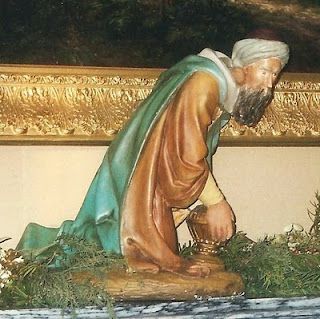Applying paint to sculpture is something of a puzzle. Although three-dimensional, it can still look flat and static if you just slap a coat of paint on. When I painted Jan Karon's Nativity figures I opted for an illusionistic approach to color. In other words, I didn't just rely on the light and shadows that would appear naturally; I enhanced them in my color choices. I approached the figures as I would if I were painting on canvas, using highlights and midtones as well as dark areas.
Perhaps you have picked up a Nativity grouping that needs improvement or have other sculptures you'd like to paint. Here are a list of helpful hints. At least I hope they're helpful.
My first suggestion is to get yourself a bunch of plaster sheep and practice, practice, practice. It's very relaxing. I can't decide if this flock, stored away in Ms. Karon's attic, is amusing or menacing.
Check out those very dramatic shadows !
Continuing with other, more practical suggestions:
2. Read about color. Anything by the Bauhaus author Johannes Itten will provide a clear explanation of the dimensions of color: value, saturation (or intensity), temperature.
3. Experiment with layering color. To do this I recommend oil paint, but acrylic will also work. The idea is to put a base color down and after it dries, brush or rub a semi-transparent color over it.
 The rust colored clothing worn by the kneeling Wise Man was painted in layers. I applied a golden yellow to the base and then added various glazes of brown and crimson. One advantage of this approach is that you can achieve a luminosity that is not possible in a one-layer approach.
The rust colored clothing worn by the kneeling Wise Man was painted in layers. I applied a golden yellow to the base and then added various glazes of brown and crimson. One advantage of this approach is that you can achieve a luminosity that is not possible in a one-layer approach.5. Save crummy old brushes and used toothbrushes. They are invaluable for glazes when you want to add texture. The beards of the Wise Men above were done with my very worst brushes.
6. Let accidents happen. Paint is a very forgiving medium. Even if you decide to cover up a "mistake," you may find that letting some of it peak through an added layer of paint will make the texture richer.
7. Paper towels are often as effective as brushes for texture and to rub on glazes, Bounty is my favorite.
Thanks to all the posters over at the Mitford website for your nice comments. I'm glad you enjoyed seeing Father Tim's figures.



No comments:
Post a Comment